Liberia
Liberia, regarding stamps represented by the I.G.P.C., has issued in 2001 a large series of stamps and blocks with as theme historical motorcycles. In this series there are quite some mistakes.
The designer has entitled the series "100 years motorcycles", but we all know that the first motorcycle, Daimlers Einspur, was already built in 1885 and thus was already 116 years old in 2001, the year of issue of the series of Liberia. The oldest motorcycle depicted in this series, an F.N. from 1905, was on the date of issue less old than a century, so this can also not justify the title.
The complete series consists of six loose stamps, two blocks of six stamps each and two blocks with one stamp.
On the loose stamp of $ 5.00 is an image of the Zenith Gradua from 1907.
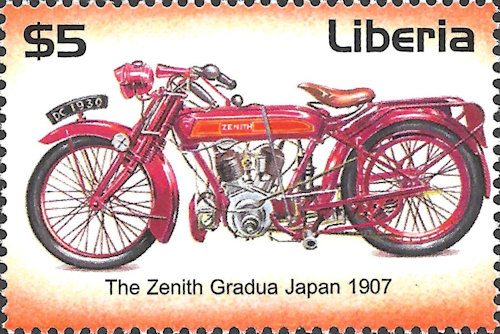
Zenith produced motorcycles with engines from amongst others J.A.P. (John Alfred Prestwich). The Gradua-Gear was a kind of DAF-like stepless transmission, invented by Zenith chief-engineer Barnes, with a variable belt pulley and a forwards and backwards moving rear wheel, both operated at the same time by a turning handle next to the tank. This system made the Zenith almost invincible in this time of driving by (slipping) belts.
The designers of this stamp saw the indication of the engine, J.A.P., as indication that the motorcycle is originating from Japan, but the factory was located in
Finsbury Park (Noord-London). Also the year 1907 is completely impossible because J.A.P. not earlier than in 1912 cut off a slice from the V8 engine that was in 1910 designed for aeroplanes, and converted this V-twin for use in motorcycles and cars (Morgan).
The same motorcycle is also shown in the margin of the first collection block from Liberia.
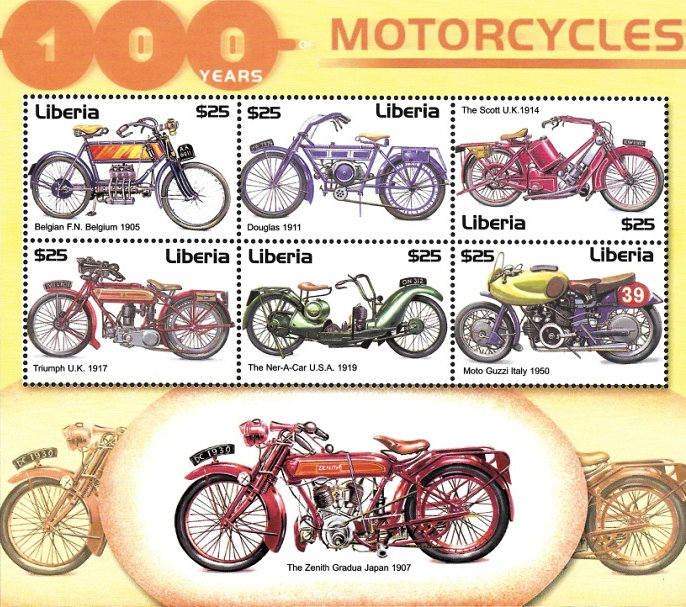
Apart from that the first steps of Zenith in the world of transport were done with the so-called Bi-Car, a two-wheeler with center hub steering. The name Bi-Car was an indication to the many technical gadgets that could before that only be found in cars, like a starting handle, no pedals but footboards and a "comfortable" double sprung frame.
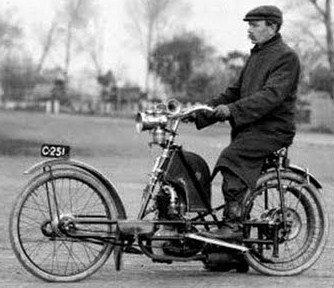
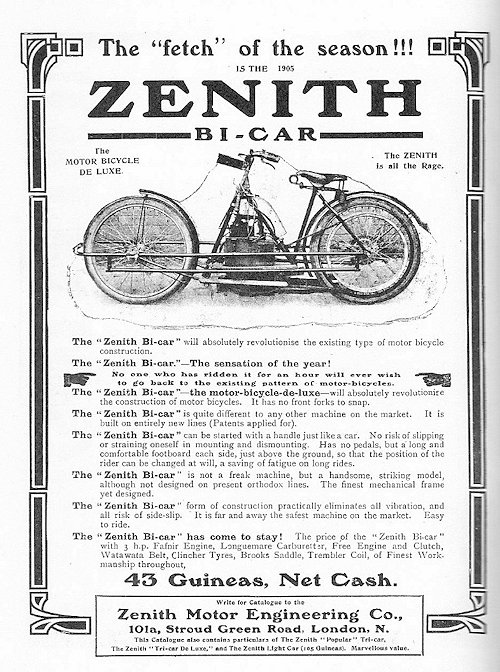
The second stamp is the one with the Dollar VY.
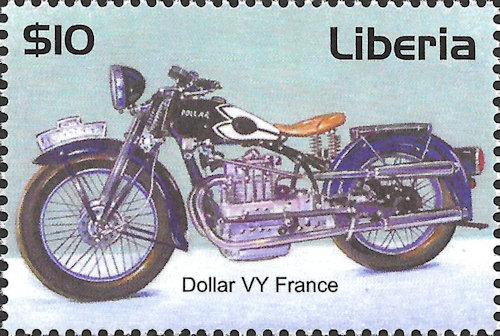
Dollar, started in 1908 as bicycle manufacturer (Omnium and Spencer), made its first car in 1907, the Foucher & Delachanal. In 1923 the company showed their first motorcycle on the Paris' Salon. On the stamp the VY from 1932. This had a 750 V4 engine with a very small angle of 14 degrees, cardan shaft drive and a battery-coil ignition. Nice to know: Delachanal also fabricated the Majestic that he designed for George Roy.
Next stamp in the row is the BMW R 75/6 from…… 1970(?).
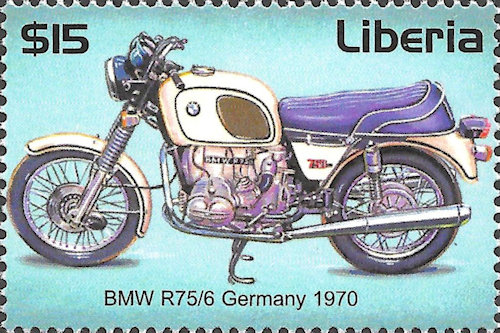
The 5-series of the Bayerische Motor Werke ran to the year 1974 and in that year the first /6 BMW came on the market. Thus 1970 is not possible for a six-series BMW. The six differed on a few points from the five-series: the front brake became a disc brake, the speedo- and tachometer were placed outside the headlight and, the largest aesthetic difference, the chromed sides of the tank were replaced by rubber kneepads. But ok, the /6 series thus just came on the market in 1974.
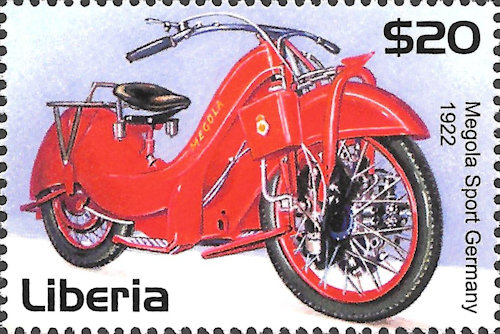
The Megola was only produced during a short period: between 1921 and 1925 the factory produced around 2000 motorcycles.
They used a five-cylinder star engine for the driving, built into the front wheel. The company originally was started under the name Pax. This was later replaced by MeGo, a combination of Meixner and Cockerell (in German Gockerell), and when money-lender Landgraff joined the two the name was extended to MeGoLa. The Megola had one big problem: the fuel tank. To bring the petrol to the front wheel it was chosen to install 2 tanks next to the front wheel. Filled this position did not give problems, but when the tanks became empty gravity had an unfavourable effect on the steering. In 1925 the company went bankrupt.
The $ 30.00 stamp shows a Rolls Royce motorcycle from 1938.
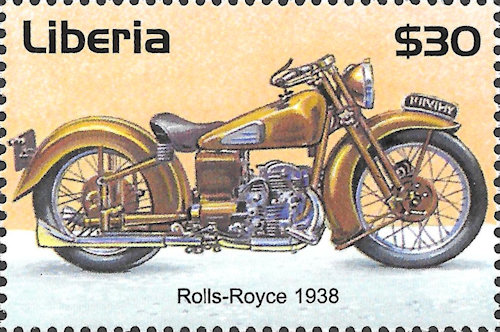
Rolls Royce is one of the leading car brands in the world, and their name is often used as superlative for quality. Brough Superior is such a high-quality product that deserves the name "Rolls Royce". George Brough, son of motorcycle manufacturer William Edward Brough, aimed at building the most perfect motorcycle. Although the name of his brand contained the word Superior, his father often called George's brand "Inferior", but in reality it was superior. In 1940 the factory was requisitioned to build aeroplane engines for Rolls Royce of the type Merlin, named after a falcon species. Of these engines 150.000 have been built. After the war there were no good engines like J.A.P. available, and the production of Brough Superior ended after 21 years, with 3048 motorcycles of 19 different models.
The model shown on the stamp is the
Brough Superior Golden Dream with an H-engine. This should be the ultimate engine design of all times, and saw the light of day in 1938. An H-engine has 2 coupled crankshafts and opposing cylinders. This model from Brough S. was (is) affectionately called "the Rolls Royce of motorcycles". There were only 4 of this model known, one (riding) owned by the president of the B.S. club in Nottingham, England, two under reconstruction, and one in the Birmingham Motorcycle Museum, which I have personally touched before it was destroyed by the big fire in 2003, but also this one will without doubt be rebuilt.
The last loose stamp is the one of $ 40.00 and shows us a Harley-Davidson Sportster XLCH 100 USA edition.
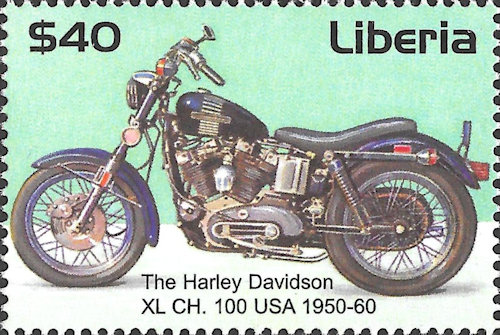
Although the type indication letters from Harley are almost impossible to understand, the history of these Sportsters has been extensively described. Already in 1938 the rules of track races have been adapted to create equal chances for private riders. In the track class overhead valve motorcycles until 500 cc were allowed, and side valve engines up to 750 cc. After 1945 the Harleys could not compete anymore with the lighter English 500 cc motorcycles, and the K block was adapted for the C-class (Competition). It was a 750 cc 45 degree V-twin lightweight block, still with side valves but so good that it won every race until 1963. The motorcycle was also sold in a streetlegal version: the XLCH 100.
Explanation of the letters:
X=Sport/Special Construction, L=wide front tyre, C thus for Competition and the H means in this case Higher (performance). The Sportster series is still part of the present model line-up from HD.
The first stamp block of the issue shows a Goodman HDS 1200.
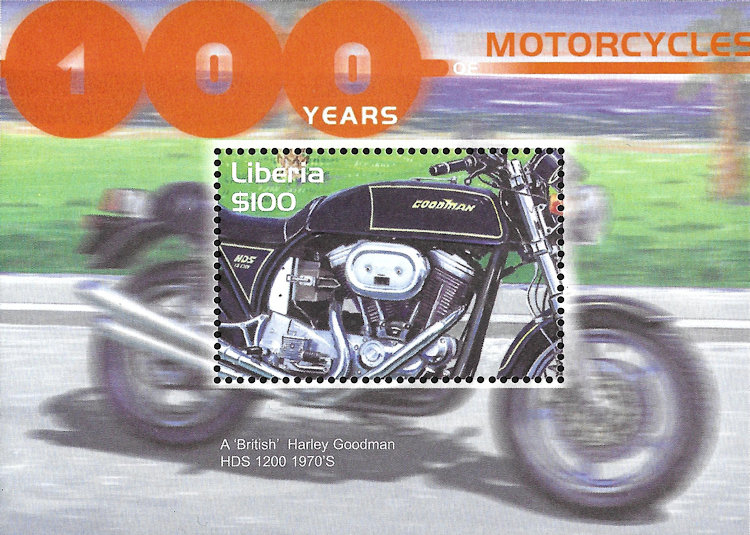
Simon Goodman, son of the founder of the Velocette company, wanted to get the rough, rattling Harley married with a British legend, the Featherbed frame. To achieve this he placed the Sportster engine in a classic Norton frame with many other European features. He damped the vibrations of the engine to almost nil by means of a self-designed rubber suspension. The Goodman is known as one of the Super motorcycles of the previous century. Simon built not more than 10 of these motorcycles, and in the last decennia 4 more have been assembled from spare parts. Although they were already expensive when new, nowadays such a bike costs easily the price of a villa.
The second block of the series again shows a Harley-Davidson, now the FXE like this could be found on the road in 1977.
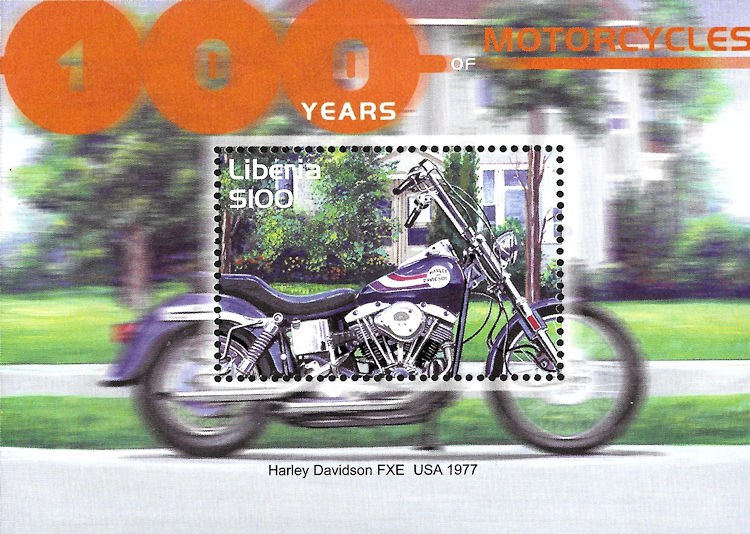
The F-letter means that the engine is equipped with overhead valves, and this engine is better known as the Big Twin Block. The second letter, the X, indicates that the front wheel is provided with a narrow tyre, and the E indicates that you don't have to kick as an electrical starter is installed on the motorcycle. The bike belongs to the Super Glide series, the series with shocks on the back instead of the non-suspended frame of the Hardtail series.
The series contains 2 other blocks with images of motorcycles, more about that next time.
Hans de Kloet
Top - Back to former page - Home |










